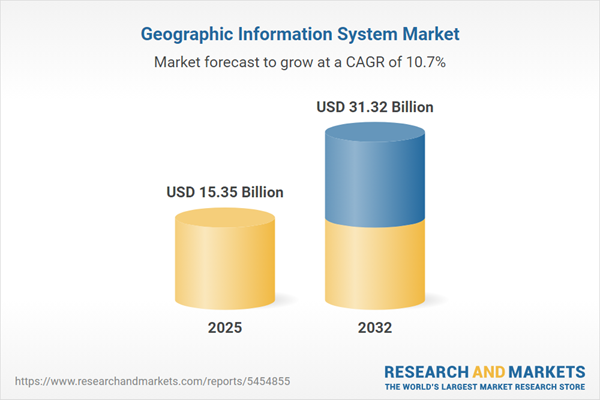Speak directly to the analyst to clarify any post sales queries you may have.
The geographic information system (GIS) market continues to transform global industries, driven by rapid technological advancement and an expanding set of applications. As GIS capabilities evolve, organizations are leveraging geospatial intelligence to sharpen decision-making, enhance resilience, and sustain competitive positioning across public and private domains.
Market Snapshot: Geographic Information System Market Expansion and Growth Outlook
The Geographic Information System Market grew from USD 13.92 billion in 2024 to USD 15.35 billion in 2025. Continued market momentum is forecast, with a compound annual growth rate (CAGR) of 10.66%, projecting the market to reach USD 31.32 billion by 2032. This growth is fueled by advances in spatial analytics, increased adoption of cloud-native architectures, and integration with technologies such as artificial intelligence and machine learning.
Scope & Segmentation of the Geographic Information System Market
- Components: Hardware (GPS devices, remote sensors), Services (installation, maintenance, support), Software (data analytics, 2D and 3D visualization tools)
- Technology Type: GIS software, remote sensing (including hyperspectral and multispectral imaging)
- Device Type: Desktop and mobile devices, including smartphones and tablets
- Functionalities: Mapping and surveying, territorial analysis, urban planning
- Deployment Model: Cloud-based and on-premise solutions
- End-User Industry: Agriculture, banking and finance, healthcare, retail, transportation and logistics
- Application: Disaster management, environmental monitoring, resource management (mineral and water), utilities management
- Regions Covered: Americas (North America and Latin America), Europe, Middle East & Africa, Asia-Pacific
- Leading Companies: Key vendors include Environmental Systems Research Institute, Autodesk, Trimble, Hexagon AB, Google, Microsoft, and others
Key Takeaways for Senior Decision-Makers
- Cloud-native GIS platforms enable fast deployment and foster collaboration across geographically dispersed teams.
- AI and machine learning are enhancing spatial analytics, providing more reliable predictive capabilities for urban and environmental planning.
- Edge computing and expansive sensor networks are allowing organizations to process and act on geospatial data in real time, improving critical response efforts in scenarios such as logistics and disaster management.
- The democratization of GIS through open source toolkits and mobile solutions is enabling smaller organizations, research institutions, and civic groups to build domain-specific applications.
- Strategic integration between GIS solution providers and telecommunications partners is accelerating the rollout of low-latency applications essential for remote and mobile operations.
- End-user industries are adopting GIS for a diverse range of applications, from optimizing agricultural yields and managing natural resources to enhancing healthcare delivery and supporting infrastructure modernization.
Tariff Impact: Navigating Regulatory Pressures and Market Realignment
Recent tariffs imposed on imported geospatial hardware and supporting technologies are reshaping sourcing and costing strategies. Increased hardware component costs are prompting organizations to reassess procurement models, while there is heightened investment in domestic innovation, localized assembly, and digital distribution. These dynamics have led to the emergence of more resilient, regionally focused supply chains and have unveiled new opportunities for regional service providers to tailor support and deployment offerings.
Methodology & Data Sources
This report combines exhaustive secondary research—reviewing industry white papers, regulatory filings, patent databases, and academic analysis—with primary insights from interviews and surveys of industry stakeholders. Data triangulation secures reliability, while quantitative validation and scenario analysis ensure robust, actionable findings. Quality controls and rigorous data governance underpin all methodologies.
Why This Report Matters
- Offers strategic frameworks to align technology investments with market trends, segment growth, and regional opportunities.
- Helps organizations adapt to evolving regulatory landscapes, mitigate risks, and leverage emerging technologies for operational advantage.
- Delivers actionable insights for senior leaders to drive innovation, foster resilient supply chains, and tailor offerings across varied end-user industries.
Conclusion: Strategic Direction in GIS Decision-Making
As the market evolves, leaders must prioritize adaptive technology integration, data governance, and specialized workflows to maximize value from GIS investments. Informed roadmap development and collaborative ecosystems will be key in addressing changing demands and ensuring sustainable growth across global markets.
Additional Product Information:
- Purchase of this report includes 1 year online access with quarterly updates.
- This report can be updated on request. Please contact our Customer Experience team using the Ask a Question widget on our website.
Table of Contents
3. Executive Summary
4. Market Overview
7. Cumulative Impact of Artificial Intelligence 2025
Companies Mentioned
The companies profiled in this Geographic Information System market report include:- Abaco SpA
- AmigoCloud, Inc.
- Attentive Inc.
- Autodesk, Inc.
- BatchGeo LLC
- Bentley Systems, Incorporated
- Blackshark.ai GmbH
- Blue Marble Geographics
- Cadcorp Limited
- Caliper Corporation
- Carlson Software Inc.
- CartoDB Inc.
- ComNav Technology Ltd.
- Environmental Systems Research Institute, Inc.
- Galigeo SAS
- General Electric Company
- Geospin GmbH
- Golden Software, LLC
- Google LLC by Alphabet Inc.
- Hexagon AB
- Hexasoft Development Sdn. Bhd.
- Hitachi, Ltd.
- L3Harris Technologies, Inc.
- Mapbox, Inc.
- Maxar Technologies Holdings Inc.
- Microsoft Corporation
- NV5 Global, Inc.
- Orbital Insight, Inc.
- Pasco Corporation
- Pitney Bowes Inc.
- Precisely Software Incorporated
- Shanghai Huace Navigation Technology Ltd.
- Surveying And Mapping, LLC
- TomTom International BV
- Topcon Corporation
- Trimble Inc.
Table Information
| Report Attribute | Details |
|---|---|
| No. of Pages | 183 |
| Published | November 2025 |
| Forecast Period | 2025 - 2032 |
| Estimated Market Value ( USD | $ 15.35 Billion |
| Forecasted Market Value ( USD | $ 31.32 Billion |
| Compound Annual Growth Rate | 10.6% |
| Regions Covered | Global |
| No. of Companies Mentioned | 37 |









